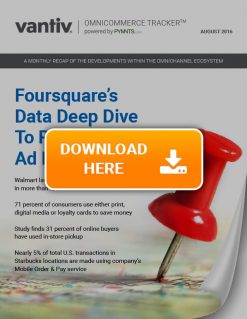Foursquare’s Data Deep Dive To Reclaim ‘Wasted’ Ad Dollars

If you believe the old adage that half of all ad dollars are wasted, retailers just don’t know which half, then close to $250B is being wasted on advertising. In August’s Omnicommerce Tracker™, Mike Harkey, Foursquare VP talks about how the granddaddy of check-ins is turning data into dollars for retailers and the brands that they sell. That, and all the omnicommerce news that is news in this month’s Tracker.
Henry Ford long ago summed up a common problem for merchants and marketers.
“I know half of my advertising budget is wasted,” Ford said back in the 1910s, “I just don’t know which half.”
In 2016, wasted advertising dollars still plague businesses.
Marketers are expected to spend more than $500 billion on advertising in 2016, according to the Chief Marketing Officer Council, and it can be notoriously difficult to determine just how effectively and efficiently that money is being spent. Are customers shopping at a particular store as a direct result of a recent ad campaign? Or is it just a coincidence?
It’s been an almost impossible question to answer, but Foursquare, a company perhaps best known as the granddaddy of social check-ins, is now looking to help advertisers and retailers do just that, thanks to a treasure trove of consumer data.
PYMNTS recently caught up with Mike Harkey, Foursquare’s Vice President of Business Development, who said that the company is using information gathered from its apps to learn more about consumer behavior and help businesses use that data to improve marketing plans and grow revenue.
“We’ve got this database of 85 million places,” Harkey told PYMNTS, “and we use it to solve real business problems for merchants.”
Building the database
Harkey said that to help businesses determine the effectiveness of their advertising, Foursquare first had to build a large stock of data around individual cities and their retailers, restaurants and other merchants.
To do that, the company used its popular Foursquare city guide app and Swarm check-in app. The apps, which currently have a user base of roughly 50 million, help consumers find new places and reward them for checking in and submitting other information. All activity adds to the database.
“That real-world discovery element is really about connecting the consumer audience to merchants in the real world. That’s at the core of our consumer proposition,” Harkey said.
Using the data collected by those two apps, the company built that 85 million location-strong database, including user locations and “interesting nuggets of information,” such as the menu or merchandise at a particular merchant, or the foot traffic that a particular location receives.
It gets more interesting when you consider how Harkey and his team are determining where consumers are likely to be before and after they visit any particular commercial site, which allows them to help drive foot traffic to individual stores.
“This technology is based on a history of, about 9 billion times, people taking their phones out of their pocket and saying ‘Hey Swarm or Foursquare, this phone is in this location,’” Harkey explained. “We’ve been able to really refine our understanding of where phones are in the real world and tune it with machine learning technology over time.”
Turning data into solutions
Now that Foursquare has built such a massive skeleton of data, Harkey said, the company is using it to help merchants and marketers better understand consumer behavior. The company recently rolled out a new tool for businesses called Attribution.
Attribution is a dashboard that allows marketers to see the results of an advertising campaign, and compare the behavior of consumers who viewed the campaign with that of those who did not.
“The marketer can actually see the real world activity of the action between an exposed audience and compare it to an audience that didn’t see the campaign,” Harkey said, “and then see how it performs.
The company has also published case studies of high-profile companies, including a study forecasting Chipotle’s sales after the popular chain’s food was found to be tainted with E. coli in some locations.
They’ve also correctly anticipated sales of the Apple iPhone 6S and recently analyzed the impact of Donald Trump’s presidential campaign on foot traffic at Trump-branded hotels, casinos and restaurants. Harkey noted that those public studies often bring in new clients hoping for similar acumen.
“Merchants come to us and say, ‘What can you tell me about what’s happening in my market?’” Harkey said. “We’re uniquely positioned with this data set to tell something interesting to merchants on the insight side.”
Helping online and offline match up
The solution is especially useful for merchants trying to figure out how their online marketing relates back to their sales in an offline, brick-and-mortar location.
“It’s the online-to-of ine conversion funnel that is the holy grail for advertisers and merchants. That connection between what happens online and what people do in the real world has been puzzling advertisers forever,” Harkey said. “Historically, it’s not had the insights that one can glean from the pixels and performance data that one can track and measure online incredibly well.”
Harkey said that marketers often engage his team hoping to find out how online campaigns affect consumer behavior in the real world. To answer that question, Harkey said, he and his team use those tools to provide marketers with a clear picture of how well they spend their online ad dollars.
He noted that the data gives marketers the power to not only learn what half of their marketing budget may be “wasted,” but the ability to determine how to x it.
“I think with this data, it’s power, it’s the ability to be able to course correct as the campaign runs,” Harkey said. “To be able to tune that is really powerful.”
Harkey said that he and his team can use their history with larger companies to prove to potential clients that they have the right solutions to answer those questions.
Foursquare plans to use that engagement to help big name companies, like AT&T, Anheuser-Busch and Samsung, who have all previously partnered with Foursquare, to determine just how effective individual ad campaigns are.
“When these companies choose to build on top of our database, on top of our technology,” Harkey said, “I think it’s incredibly validating of what we’re doing and the quality of our data.”
Harkey said that he and his team can use their history with larger companies to prove to potential clients that they have the right solutions to answer those questions.
“What this does is it gives merchants the peace of mind and the confidence that the world’s largest technology companies and hedge funds have vetted Foursquare data and said ‘That’s the data set we believe in,’” Harkey said. “If I’m a retailer running marketing, I can really trust the results I’m seeing, so that’s something that we’re really excited about going forward.”
Time will tell if all that data can truly match online marketing with offline success.
To download the Tracker, click the button below:

